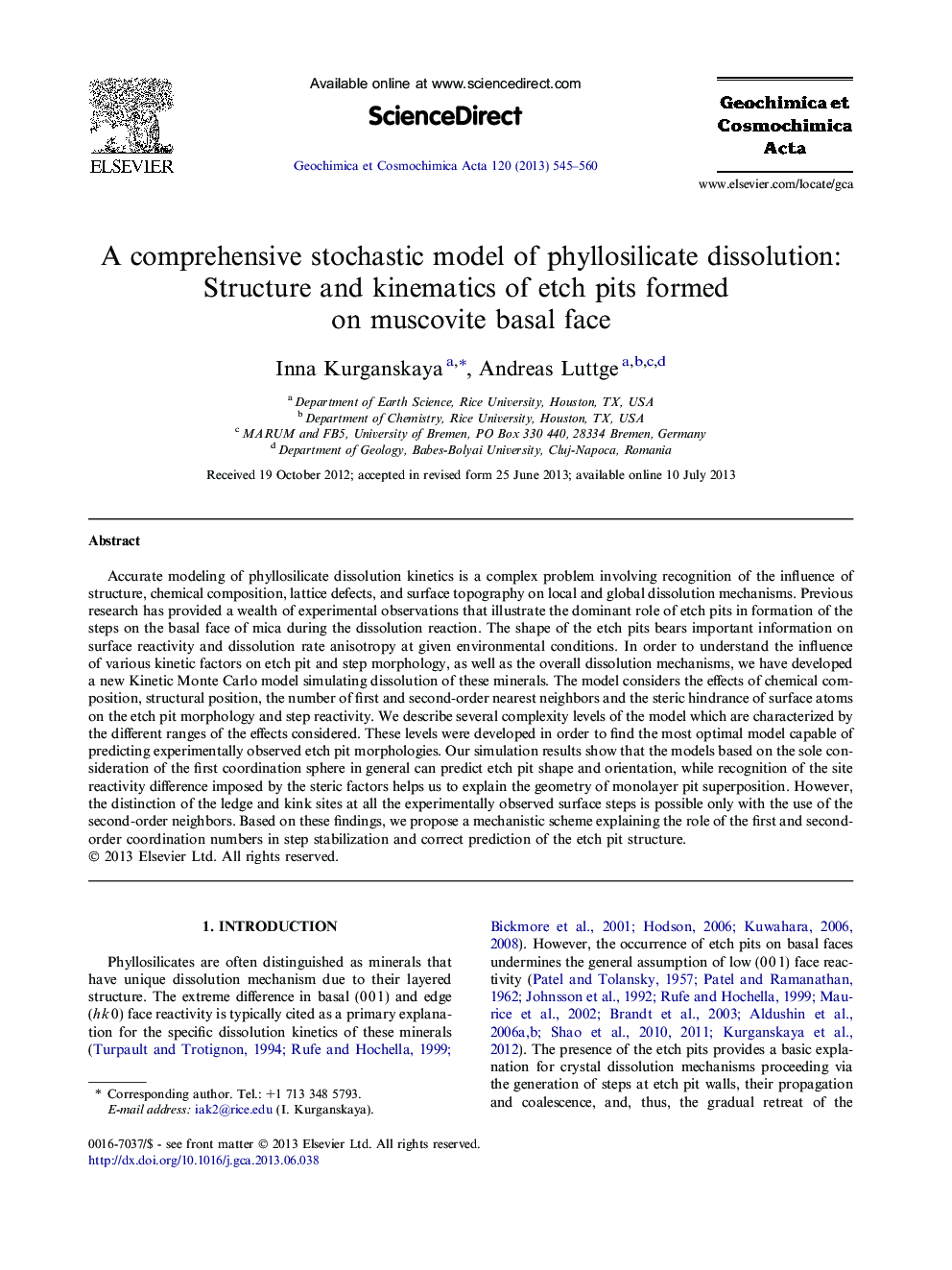| کد مقاله | کد نشریه | سال انتشار | مقاله انگلیسی | نسخه تمام متن |
|---|---|---|---|---|
| 6439030 | 1638037 | 2013 | 16 صفحه PDF | دانلود رایگان |
عنوان انگلیسی مقاله ISI
A comprehensive stochastic model of phyllosilicate dissolution: Structure and kinematics of etch pits formed on muscovite basal face
ترجمه فارسی عنوان
مدل جامع تصادفی از انحلال فیلیسلیکات: ساختار و سینماتیک چاله های اچ ای شکل گرفته در چهره پایه مسکووییت
دانلود مقاله + سفارش ترجمه
دانلود مقاله ISI انگلیسی
رایگان برای ایرانیان
ترجمه چکیده
مدل سازی دقیق سینتیک انحلال فیلیسلیکات یک مشکل پیچیده است که شامل شناخت تأثیر ساختار، ترکیب شیمیایی، نقص شبکه و توپوگرافی سطح در مکانیسم های انحلال محلی و جهانی است. تحقیقات پیشین، مجموعه ای از مشاهدات تجربی را ارائه می دهد که نقش مهمی از چاله های اچ در شکل گیری مراحل چهره پایه میکا را در طی واکنش انحلال نشان می دهد. شکل چاه های اچ دارای اطلاعات مهمی در مورد واکنش پذیری سطح و آنیزوتراپی سرعت انحلال در شرایط محیطی داده شده است. به منظور درک تاثیر عوامل مختلف جنبشی بر مورفولوژی گودال و گشتاور اچ، و نیز مکانیزم های انحلال کلی، ما یک مدل جدید مین کارلو را برای شبیه سازی انحلال این مواد معدنی توسعه دادیم. در این مدل، اثرات ترکیب شیمیایی، موقعیت ساختاری، تعداد نزدیکترین همسایگان اول و دوم مرتبه و مانع استریک اتم های سطحی بر روی مورفولوژی گودال اکتیو و واکنش پذیری مرحله بررسی می شود. ما چند سطح پیچیدگی مدل را توصیف می کنیم که با محدوده های مختلف اثرات مورد نظر مشخص می شود. این سطوح به منظور دستیابی به بهترین مدل مناسب برای پیش بینی مورفولوژی گودال اچ انجام شده است. نتایج شبیه سازی ما نشان می دهد که مدل های مبتنی بر توجه تنها به اولین میدان هماهنگ به طور کلی می توانند شکل و جهت گیری ذرات اچ را پیش بینی کنند، در حالی که شناخت تفاوت واکنش پذیری سایت تحمیل شده توسط عوامل استریک به ما کمک می کند تا هندسه تکیه گاه غربالگری را توضیح دهد. با این حال، تماشای سایت های لبه و کینک در تمام مراحل سطح مشاهده شده آزمایشگاهی تنها با استفاده از همسایگان درجه دوم امکان پذیر است. بر اساس این یافته ها، ما پیشنهاد یک طرح مکانیکی برای توضیح نقش شماره های هماهنگی اول و دوم در تثبیت مرحله و پیش بینی صحیح ساختار گودال اچ است.
موضوعات مرتبط
مهندسی و علوم پایه
علوم زمین و سیارات
ژئوشیمی و پترولوژی
چکیده انگلیسی
Accurate modeling of phyllosilicate dissolution kinetics is a complex problem involving recognition of the influence of structure, chemical composition, lattice defects, and surface topography on local and global dissolution mechanisms. Previous research has provided a wealth of experimental observations that illustrate the dominant role of etch pits in formation of the steps on the basal face of mica during the dissolution reaction. The shape of the etch pits bears important information on surface reactivity and dissolution rate anisotropy at given environmental conditions. In order to understand the influence of various kinetic factors on etch pit and step morphology, as well as the overall dissolution mechanisms, we have developed a new Kinetic Monte Carlo model simulating dissolution of these minerals. The model considers the effects of chemical composition, structural position, the number of first and second-order nearest neighbors and the steric hindrance of surface atoms on the etch pit morphology and step reactivity. We describe several complexity levels of the model which are characterized by the different ranges of the effects considered. These levels were developed in order to find the most optimal model capable of predicting experimentally observed etch pit morphologies. Our simulation results show that the models based on the sole consideration of the first coordination sphere in general can predict etch pit shape and orientation, while recognition of the site reactivity difference imposed by the steric factors helps us to explain the geometry of monolayer pit superposition. However, the distinction of the ledge and kink sites at all the experimentally observed surface steps is possible only with the use of the second-order neighbors. Based on these findings, we propose a mechanistic scheme explaining the role of the first and second-order coordination numbers in step stabilization and correct prediction of the etch pit structure.
ناشر
Database: Elsevier - ScienceDirect (ساینس دایرکت)
Journal: Geochimica et Cosmochimica Acta - Volume 120, 1 November 2013, Pages 545-560
Journal: Geochimica et Cosmochimica Acta - Volume 120, 1 November 2013, Pages 545-560
نویسندگان
Inna Kurganskaya, Andreas Luttge,
